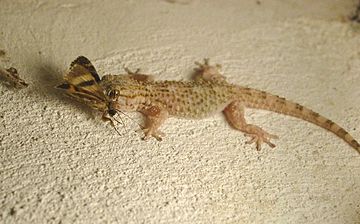Type the name of the breed you're looking for below
[wpdreams_ajaxsearchlite] Don't see the breed your're looking for? Click here and let us know!
Moorish Gecko
| Place of Origin and Range | Tarentola mauritanica is a species of gecko native to the Western Mediterranean region of Europe and North Africa and widely introduced to America and Asia. Its widespread introduction has attracted many common names, including variants on common or Moorish wall gecko and Salamanquesa, Crocodile gecko, European common gecko, and Maurita naca gecko. |
| Description | Robust body and flat head. Back, legs and tail with prominent conic tubercles. Its regenerated tail is smoother and doesn't have tubercles. Obtuse mouth, big eyes with no eyelids and vertical pupil. Fingers with big lateral growths and adherent division less laminae in the bottom face. Only the third and fourth fingers end in union. Brownish grey or brown colouration with darker or lighter spots. These colours change in intensity according to the light. When they are active by day their colour is darker than during the night. |
| Morph Patterns Available | Yes |
| Adult Size | Can grow up to 15 cm (6 in) |
| Accommodation | These animals should be housed in pairs and need a medium sized terrarium. The temperature should be between 25 and 28°C. The humidity should be not too high. Most geckos prefer warm habitat with lots of shade, hides, and lots of branches for climbing. Provide a small water dish and mist twice daily. Cover the sides of the cage when possible to prevent injury to your gecko from running into glass. |
| Lifespan | Can live 6+ years |
| Feeding / Diet | They hunt insects and in the warmer months of the year it can be found hunting nocturnal insects near light sources. |
| Breeding | They lay 2 almost-spherical eggs twice a year around April and June. After 4 months, little salamanquesas of less than 5 cm in length are born. Moorish geckos are slow to mature, taking 4 to 5 years in captivity. |
| Other Considerations | Healthy geckos with appropriate living conditions shed regularly. They shed completely and often eat their shed to the point where the keeper may not even notice that the gecko has shed. Some geckos experience shedding problems occasionally and others chronically have difficulty shedding. Signs of shedding difficulty range from large sheets of shed clinging to the head, tail or limbs to residual shed left around the eyes, on the tail tip or the toes. This shed must be removed since it can cause constrictive damage to the extremities. All geckos require calcium to maintain strong bones and vitamin D3 to aid in metabolizing the calcium. Calcium is generally supplied in powdered form in a bowl, through dusted feeders or as an ingredient in fruit. |



